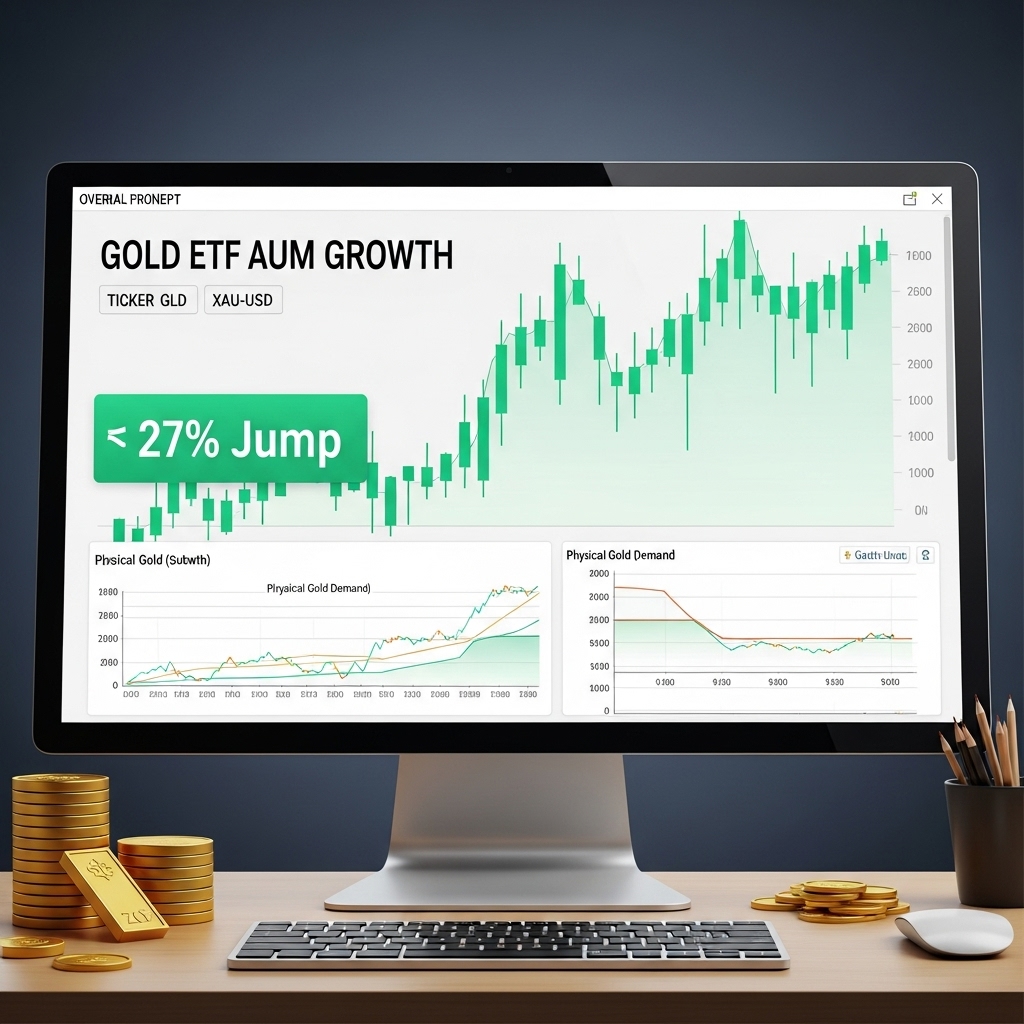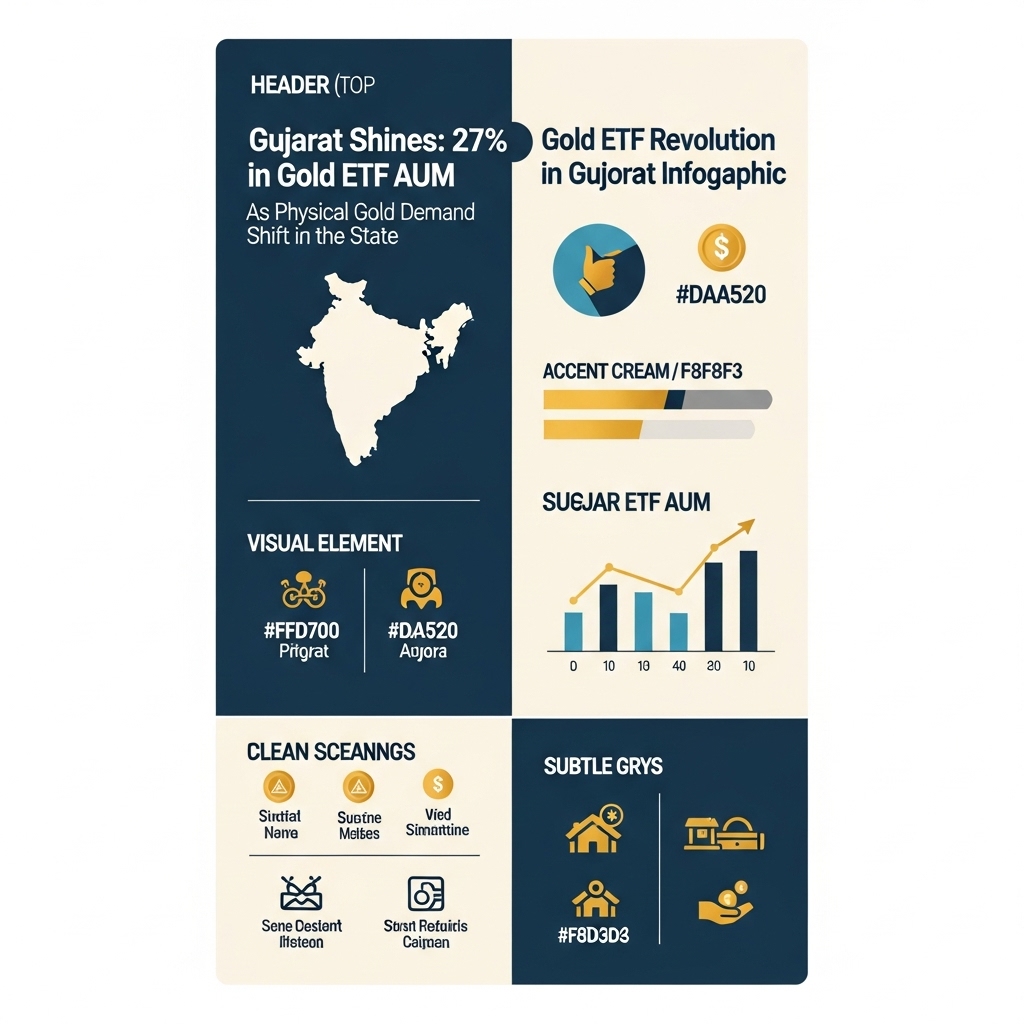The Golden Shift: Why Gujarat’s Gold ETF Boom Matters for Your Portfolio
Gold has long been the bedrock of Indian savings and a symbol of wealth, often passed down through generations in its physical form. However, a significant transformation is underway in how investors are choosing to hold this precious metal. Amidst global economic uncertainties and fluctuating market dynamics, a fascinating trend has emerged in Gujarat: a remarkable 27% jump in Gold Exchange Traded Fund (ETF) Assets Under Management (AUM), even as physical gold demand shows signs of weakening. This striking divergence isn’t just a regional anomaly; it signals a pivotal evolution in gold investment strategies across the nation, driven by convenience, liquidity, and evolving investor preferences.
In this post, we’ll delve into the factors propelling Gujarat’s rapid adoption of Gold ETFs, examining how these financial instruments are redefining traditional gold ownership. We’ll explore the distinct advantages ETFs offer—from guaranteed purity and secure storage solutions to ease of trading and superior cost efficiency—especially when compared to the practicalities and drawbacks of holding physical gold. For the discerning gold investor, understanding this trend is crucial. It highlights a modern, efficient pathway to harness gold’s acclaimed benefits as a hedge against inflation and market volatility, offering a sophisticated alternative that aligns with today’s dynamic financial landscape. Join us as we uncover what this golden shift means for your portfolio and the future of gold investing.
Gold Market Analysis and Key Insights
The notable 27% surge in Gold ETF Assets Under Management (AUM) in Gujarat, even as physical gold demand weakens, underscores a significant evolution in investor behaviour within India’s traditional gold market. This shift reflects a broader trend towards modern, efficient gold investment vehicles.
Key Market Insights
* Shift from Physical to Digital: The primary insight is the growing preference for financialized gold over physical forms. Investors are increasingly choosing Gold ETFs for their ease of trading, absence of purity concerns, and elimination of storage costs and security risks associated with physical gold.
* Investor Sophistication: The rise in ETF adoption signals an increasing financial literacy and comfort with market-linked instruments among investors. They are moving beyond traditional methods, seeking liquidity and transparent pricing.
* Inflationary Hedging and Diversification: Gold’s enduring role as a hedge against inflation and a portfolio diversifier remains strong. In uncertain economic climates, investors often turn to gold to preserve capital, a sentiment that translates well into ETF investments.
Current Gold Market Trends and Data
Globally, gold has maintained its safe-haven appeal, exhibiting resilience amidst geopolitical tensions, economic uncertainties, and persistent inflationary pressures. While the U.S. dollar strength and interest rate hikes can occasionally provide headwinds, gold’s fundamental drivers—such as central bank buying, demand from emerging markets, and its inverse correlation with the dollar—continue to support its valuation. The Gujarat data points to a localized reflection of this global trend, where investors are strategically reallocating their gold exposure.
Investment Benefits and Considerations
Gold ETFs offer high liquidity, allowing investors to buy or sell units easily at market prices. They eliminate storage costs, insurance needs, and concerns over purity or making charges, which are inherent with physical gold. As a portfolio diversifier, gold can reduce overall portfolio volatility, especially during market downturns. However, investors must consider expense ratios (management fees) associated with ETFs, the absence of dividend yields, and the potential for tracking errors against the underlying gold price.
Expert Recommendations
Financial experts often recommend gold as a strategic, long-term asset allocation rather than a short-term trade. A modest allocation, typically 5-15% of a diversified portfolio, is suggested to benefit from its hedging properties without over-concentration. Investors should conduct due diligence on the specific ETF’s expense ratio and underlying physical gold holdings. A Systematic Investment Plan (SIP) in Gold ETFs can help average out purchase costs and mitigate price volatility over time.

Gold Investment Strategies and Options
The noticeable shift towards Gold ETFs in Gujarat, indicative of weakening physical demand, underscores evolving investment preferences. Investors have diverse avenues to gain gold exposure, each with unique characteristics and risk profiles.
Investment Options & Strategies:
* Physical Gold: Includes jewelry, coins, and bars. While tangible, it incurs storage costs, raises purity concerns, and involves higher transaction fees (e.g., making charges).
* Gold Exchange Traded Funds (ETFs): Offer gold exposure in dematerialized form, tracking physical gold prices. They provide high liquidity, transparency, and eliminate storage hassles.
* Sovereign Gold Bonds (SGBs): Government-backed securities that yield a fixed interest (currently 2.5% p.a.) and offer capital gains tax exemption on maturity. They remove storage and purity issues but have a longer lock-in period.
* Gold Mutual Funds & Digital Gold: Provide indirect or fractional ownership, respectively, though their regulatory clarity and expense structures can vary. Gold serves as an excellent portfolio diversifier and a hedge against inflation and currency devaluation.
Risk Assessment & Portfolio Allocation:
Gold prices can be volatile. Financial advisors typically suggest allocating 5-15% of a diversified portfolio to gold, depending on individual risk tolerance and financial goals. Physical gold carries security and liquidity risks, whereas ETFs and SGBs significantly mitigate these concerns.
Comparison of Methods:
Gold ETFs are highly liquid, making them suitable for short-term trading or tactical asset allocation. SGBs are ideal for long-term investors prioritising income, tax efficiency, and no physical handling. Physical gold appeals to traditional buyers valuing direct ownership, despite its practical drawbacks.
Market Timing Considerations:
Gold prices are heavily influenced by global economic conditions, interest rates, and geopolitical stability, often performing well during uncertainty or high inflation. While market timing is challenging, adopting a staggered investment approach (like Systematic Investment Plans in ETFs or regular SGB purchases) can average out acquisition costs and reduce risk. Investors should align their gold strategy with their specific time horizon and financial objectives.
Market Performance and Outlook
Gujarat’s notable 27% surge in Gold ETF AUM highlights a significant shift towards financialized gold investments, contrasting with weakening physical demand. Historically, gold has served as a crucial safe-haven asset, demonstrating strong performance during periods of economic uncertainty and elevated inflation, particularly post-2008 financial crisis and during the COVID-19 pandemic. This robust track record has bolstered investor confidence in digital gold avenues.
Currently, global macroeconomic headwinds and persistent inflationary pressures are key drivers supporting gold prices. Central bank policies, especially the trajectory of interest rates by the RBI and Federal Reserve, heavily influence gold’s appeal; higher real interest rates generally temper demand, but inflation hedging remains a powerful catalyst. Geopolitical tensions further amplify gold’s allure as a diversification tool. The transition from physical to ETF gold reflects a desire for liquidity, purity assurance, and cost-effectiveness among modern investors.
Looking ahead, the outlook for Gold ETFs appears positive. Continued global economic volatility, coupled with potential currency depreciation and the ongoing trend of financialization, is expected to sustain inflows. While a strong economic recovery or sharp rise in real interest rates could pose headwinds, gold’s intrinsic value as a store of wealth, coupled with increasing investor sophistication, suggests a steady demand for Gold ETFs. This trend points towards a maturing gold investment landscape in India, favoring structured, transparent products over traditional physical forms.
Frequently Asked Questions About Gold Investment
What is a Gold ETF?
A Gold Exchange Traded Fund (ETF) is an investment instrument that tracks the domestic price of physical gold. It represents gold in an electronic form, allowing investors to buy and sell gold units on stock exchanges without physically holding the metal.
Why are investors shifting from physical gold to Gold ETFs?
The shift is often driven by factors like convenience, purity concerns, storage costs, and liquidity. Gold ETFs eliminate issues such as making charges, storage safety, and the hassle of physical transactions, making them a more appealing option.
What are the key benefits of investing in Gold ETFs?
Benefits include ease of trading (like stocks), purity assurance, no storage costs or safety concerns, high liquidity, and cost-efficiency (no making charges or locker fees). They also offer transparency in pricing as they mirror the real-time gold price.
Is Gold ETF investment safer than holding physical gold?
In many ways, yes. Gold ETFs mitigate risks associated with physical gold like theft, purity doubts, and high making charges. The units are held in a demat account, providing a secure, electronic record of ownership and eliminating physical storage worries.
How can one invest in Gold ETFs?
To invest in Gold ETFs, you need a demat account and a trading account with a stockbroker. You can then buy or sell ETF units on the stock exchange through your broker, similar to buying or selling shares of a company.
Does this trend in Gujarat signify a broader shift in gold investment?
While specific regional data, the trend in Gujarat reflects a growing national preference for digital gold investments. Investors across India are increasingly opting for financial instruments like Gold ETFs and Sovereign Gold Bonds due to their inherent advantages over physical gold.

Final Thoughts on Gold Investment
The significant 27% surge in Gold ETF AUM in Gujarat, amidst softening physical demand, clearly signals a profound shift in how investors are approaching gold. This trend highlights a growing preference for the convenience, liquidity, and safety offered by digital gold over traditional forms. For modern gold investors, the key takeaway is the increasing relevance of financial instruments like Gold ETFs, which provide exposure to gold’s value appreciation without the associated storage and purity concerns of physical holdings.
Our final recommendation for investors is to embrace this evolving landscape. While physical gold retains its cultural significance, diversifying your portfolio with Gold ETFs offers a smart, accessible way to leverage gold’s stability and growth potential. Consider Gold ETFs for efficient, transparent, and liquid gold exposure. Explore how these instruments fit into your financial strategy and consult a financial advisor to make informed decisions for a truly golden future.